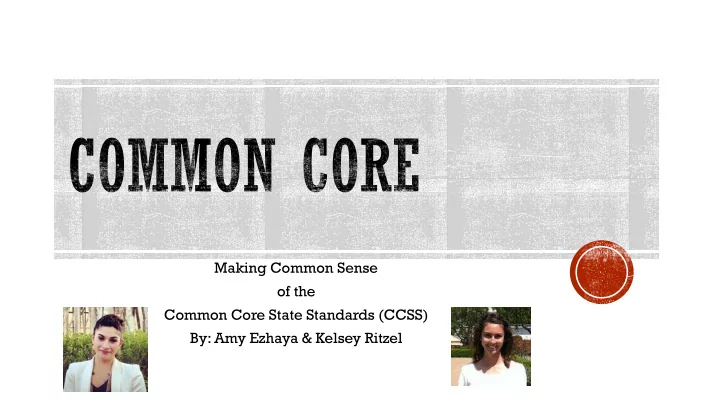

Making Common Sense of the Common Core State Standards (CCSS) By: Amy Ezhaya & Kelsey Ritzel
Common Core Background and Statistics Why the switch to Common Core The way Common Core is Structured School on Wheels and Common Core Differentiation: What is it? What does Common Core look like: ELA/Math Resources
The Common Core is a set of high- quality academic standards in mathematics and English language arts/literacy (ELA). These learning goals outline what a student should know and be able to do at the end of each grade. The standards were created to ensure that all students graduate from high school with the skills and knowledge necessary to succeed in college, career, and life, regardless of where they live .
A.State led effort, not federal mandate B.Internationally benchmarked C.Incorporates 21 st century learning styles D.The standards are consistent from state to state E.Created by collaborative group F.The goal is to help create students who are equally college and career ready
PREPRATION COLLABORATION COMPETITION EQUITY CLARITY
•By 2018, 61% of jobs in California will require postsecondary education. •This is 2 percentage points below the national average of 63% . •California ranks 29th in postsecondary education intensity for 2018.
Traditional Classroom Common Core Classroom
How the standards are structured.
CCSS.ELA-LITERACY.RL.K.1 With prompting and support, ask and answer questions about key details in a text.
Reading Writing Speaking & Listening Language http://www.cde.ca.gov/be/st/ss/documents/finalelaccssstandards.pdf
Counting and Cardinality Number & Operations in Base Ten Geometry Measurement & Data http://www.cde.ca.gov/be/st/ss/documents/ccssmathstandardaug2013.pdf
How and why are we doing this? What resources are available to our tutors?
Mobility from school district to school district no longer an issue Able to use assessments to identify exact gaps Consistency between what student is learning in school and after school Similar lessons with similar approaches to teaching and learning New websites tailored just to common core curriculum Streamlined approach across all learning modalities
Google Folder: ELA Google Folder: Math Each grade Each Grade ELA Math Reading Counting and Cardinality Book List Reading Informational Texts Number & Operations in Base Ten Reading Literature Operations & Algebraic Thinking Reading Foundational Skill Geometry Writing Language Measurement & Data Speaking and Listening Worksheets Worksheets Assessments Assessments
Kindergarten ELA Subjects Materials List Assessments Worksheets Language Common Core Standards Lesson Plans One lesson demonstrating each standard Example L.K.1
How can we help our student’s achieve more rigorous standards when they are below grade level or challenged by a disability?
Breaking down a concept into more manageable parts; also referred to as scaffolding or chunking
Student centered approach Hands on Manipulatives Real world examples (Why is this important?)
Graphic organizers Discussion of text “Close Reading” Connections Vocabulary
Examples Focus on text-dependent What does the character mean questions when they say…? Can only be answered with What do the character’s words and evidence from the text actions tell you about them as a Can be literal but can also involve person? Use specific examples analysis, synthesis, and evaluation from the text to support your answer. Focus on words, sentences and paragraphs, as well as larger ideas, In the story why does the themes, or events character…? Focus on difficult portions of the text in order to enhance reading More why and how questions proficiency
Specific activities you can use with your students to help them gain mastery of common core standards.
Reading and discussion (close reading) Graphic organizers Vocabulary activities Context clues Frayer model Create a representation Word and definition match Highlight prefixes and suffixes Florida Center for Reading Research
Counting and cardinality (Scavenger hunt, I Spy) Classifying Shapes (give students different shaped objects and have them count the number of sides, match alike shapes, etc.) Newspaper hunt- have your student look for and cut out specific numbers (1-10 or 1-20) from an old newspaper or magazine, then put them in numerical order Basic facts practice (Flash cards, Dice game) What coins do I have? Game- Chose some coins and hold them so that your student cannot see them then give clues such as “I have three coins that are worth 7 cents?” and have the child use reasoning to figure out which coins your have.
Council of the Great City Schools- Parent Roadmaps http://www.cgcs.org/Domain/36 Florida Center for Reading Research http://www.fcrr.org/curriculum/SCA_CCSS_index.shtm Common Core State Standards Initiative http://www.corestandards.org/ Achieve the Core achievethecore.org Teach Thought 50 Resources http://www.teachthought.com/teaching/50-common-core-resources- for-teachers /
Recommend
More recommend